Tag: design-tool
-
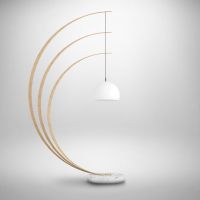 Digital Structures offers a workshop on active bending simulation at AAG 20182018-04-25, Tags: computation fabrication design-tool form-finding bending-active shaping
Digital Structures offers a workshop on active bending simulation at AAG 20182018-04-25, Tags: computation fabrication design-tool form-finding bending-active shapingThe workshop will explore the design of bending-active structures with variable cross-sections to fit a target design shape. Over the two days, the participants will use computational form-finding tools for bending-active structures, and design and build an arc lamp. The participants will learn state-of-the-art methods for simulating bending-active behavior, and for the control and optimization of their equilibrium shapes. These methods can be applied to the design of large scale bending-active structures such as elastic gridshells. The workshop is appropriate for all levels of expertise with bending-active simulations; we will provide the participants with computational tools and workflows to successfully design their own sculptures.
Register here!
-
 Mohamed Ismail Presents at ACSA 20182018-03-17, Tags: conceptual-design conceptual-structural-design constructabililty design-tool shell-structures structural-optimization visualization
Mohamed Ismail Presents at ACSA 20182018-03-17, Tags: conceptual-design conceptual-structural-design constructabililty design-tool shell-structures structural-optimization visualizationMohamed presented his paper entitled "Resistance Through Form: Synthesis Structures in the Design of a Residential Architecture for Khartoum, Sudan" at the Association of Collegiate Schools of Architecture's (ACSA) 106th Annual Meeting in Denver, Colorado, on March 17th, 2018. He presented his paper in the session "Architecture of the other 99%? – Power, Economy, and the Dilemma of History", and then joined a panel discussion moderated by Professor Ole Fischer of the University of Utah.
-
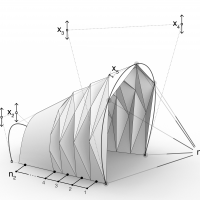 Structural optimization of folded plate structuresResearch, 2016
Structural optimization of folded plate structuresResearch, 2016This project explores the potential of folded plate structures to be a structurally optimized architectural typology.
A custom Grasshopper script was developed in which the designer can determine the form of a spanning folded plate structures by adjusting the control points of two curves through which the base surface is lofted. The input geometry is then connected to two different optimizers, Goat and Digital Structure's own Stormcloud, to generate different optimized alternatives close to the base shape.
The findings demonstrated that the folded plate typology inherently performed better than a continuous shell of the same shape. Structural optimization was shown to offer a wide design space for the global morphology of folded plate structures.
A video overview of the parametric modeling process and a few case studies is presented here.
-
 Integrating constructability into conceptual structural design and optimizationAbbigayle Horn, MIT MEng Thesis, 2015
Integrating constructability into conceptual structural design and optimizationAbbigayle Horn, MIT MEng Thesis, 2015This thesis encourages interdisciplinary design exploration through consideration of constructability in conceptual structural design. Six new metrics are introduced to measure variability in structural components, impose reasonable construction constraints, and encourage standardization of structural characteristics which can improve the ease, efficiency, and costs of construction. This thesis applies these original constructability metrics to truss façade structures for an objective, quantitative comparison with structural performance metrics. The primary contribution of these new metrics is a computational method that can aid in identifying expressive, high-performing structures in the conceptual design phase, when decisions regarding global structural behavior have the greatest impact on multi-objective project goals.
-
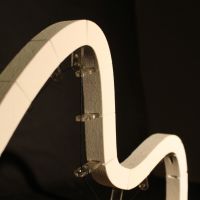 Externally post-tensioned structures: validation through physical modelsLeonardo Todisco and Caitlin Mueller, Proceedings of the 3rd International Conference on Structures and Architecture, 2016
Externally post-tensioned structures: validation through physical modelsLeonardo Todisco and Caitlin Mueller, Proceedings of the 3rd International Conference on Structures and Architecture, 2016Funicular structures, which follow the idealized shapes of hanging chains under a given loading, are recognized as materially efficient structural solutions because they exhibit no bending under normal loading conditions and minimize the amount of required members, often reducing the amount of material needed. However, non-structural conditions, such as aesthetics, functionality, and geotechnical issues, often prohibit selection of a structurally ideal funicular shape: bending moments inevitably arise, decreasing the structural efficiency of the design.
This paper briefly describes how a new design philosophy consisting in the introduction of additional loads, using external post-tensioning cables, can convert a non-funicular structure into a funicular one without changing its starting geometry. This system is based on the possibility of introducing external forces into the main structure through a system of stressed tension cables and compressive or tension struts resulting in changing internal force distribution.
The theoretical approach, based on graphic statics, has been generalized for any two-dimensional geometry. The method has been implemented in a parameterized and interactive environment allowing the fast exploration of different equilibrated solutions.
This paper focuses on the physical modeling, testing, and validation of structures implementing this approach. The structures are modelled through reduced-scale non-funicular geometries fabricated through additive manufacturing (3D printing), with the post-tensioning system constructed with thin cable and precise laser-cut struts. Slow motion video captures show how three different non funicular geometries (pointed-arch, circular arch and free form curve), made of discrete elements and without bending strength, stand only if the cable is working in the appropriate way, demonstrating the efficacy of the new system.
Furthermore, this paper introduces a built example on the scale of real building systems. The paper describes the design and construction process of a post-tensioned pavilion structure. This pavilion, called Funicular Explorations, serves as both a validation and demonstration of this new method, expressing the creative freedom of designers and the structural performance of the results. The design is an array of eight two-dimensional curves, made from custom-cut corrugated cardboard and nylon webbing. The array begins with a funicular parabolic arch, and progresses toward a visually expressive but structurally arbitrary shape. The external post-tensioning system contributes increasingly from one curve to the next, finally allowing the terminal free-form shape to be achieved with axial forces only.
The use of physical models, independent of their scale, is informative but also didactic, illustrating the possibilities and trade-offs in funicular explorations for architectural design. Furthermore such models demonstrate the structural concept behind the post-tensioning system in an intuitive way. The aim of this research is to allow architects and structural engineers a way to achieve high-performance, efficient, and safe designs, even when the global geometry departs from classical funicular shapes.
-
 Multi-objective optimization for early-stage architectural designResearch, 2014 - Present
Multi-objective optimization for early-stage architectural designResearch, 2014 - PresentIn traditional optimization, an algorithm can be applied to a well-defined problem to return a single solution. In architectural design, problems are rarely this simple—building design is a process full of human preferences and interrelated performance tradeoffs. Multi-objective optimization (MOO) is often more appropriate for managing the various design influences and priorities in conceptual design, but it is inherently dependent on human input throughout the process. This research presents a variety of visualization techniques and computational methods that have been developed to facilitate the use of MOO in conceptual architectural design.
-
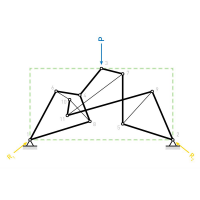 Modelling with forces: grammar-based graphic statics for diverse architectural structuresJuney Lee, Corentin Fivet, and Caitlin Mueller, Modelling Behaviour: Proceedings of the Design Modelling Symposium, Copenhagen 2015, 2015
Modelling with forces: grammar-based graphic statics for diverse architectural structuresJuney Lee, Corentin Fivet, and Caitlin Mueller, Modelling Behaviour: Proceedings of the Design Modelling Symposium, Copenhagen 2015, 2015Most architectural modelling software provides the user with geometric freedom in absence of performance, while most engineering software mandates pre-determined forms before it can perform any numerical analysis. This trial-and-error process is not only time intensive, but it also hinders free exploration beyond standard designs. This paper proposes a new structural design methodology that integrates the generative (architectural) and the analytical (engineering) procedures into a simultaneous design process, by combining shape grammars and graphic statics. Design tests presented will demonstrate the applicability of this new methodology to various engineering design problems, and demonstrate how the user can explore diverse and unexpected structural alternatives to conventional solutions.
-
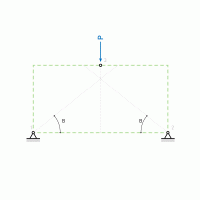 Grammatical design with graphic statics: rule-based generation of diverse equilibrium structuresJuney Lee, MIT MEng Thesis, 2015
Grammatical design with graphic statics: rule-based generation of diverse equilibrium structuresJuney Lee, MIT MEng Thesis, 2015During early stages of design, an architect tries to control space by “finding a form” among countless possible forms, while an engineer tries to control forces by “form-finding” an optimized solution of that particular form. Most commonly used parametric tools in architectural design provide the user with extensive geometric freedom in absence of performance, while engineering analysis software mandates pre-determined forms before it can perform any numerical analysis. This trial-and-error process is not only time intensive, but it also prohibits exploration beyond the design space filled with already known, conventional solutions. There is a need for new design methods that combine form generation with structural performance.
This thesis addresses this need, by proposing a grammar-based structural design methodology using graphic statics. By combining shape grammars with graphic statics, the generative (architectural) and the analytical (engineering) procedures are seamlessly integrated into a simultaneous design process. Instead of manipulating forms with multiple variables as one would in the conventional parametric design paradigm, this approach defines rules of allowable geometric generations and transformations. Computationally automated random generator is used to iteratively apply various rules to generate unexpected, interesting and yet structural feasible designs. Because graphic statics is used to embed structural logic and behavior into the rules, the resulting structures are always guaranteed to be in equilibrium, and do not need any further numerical analysis. The effectiveness of this new methodology will be demonstrated through design tests of a variety of discrete, planar structures.
Grammatical Design with Graphic Statics (GDGS) contributes new ways of controlling both form and forces during early stages of design, by enabling the designer to: 1) rapidly generate unique, yet functional structures that fall outside of the expected solution space, 2) explore various design spaces unbiasedly, and 3) customize the combination of grammar rules or design objectives for unique formulation of the problem. Design tests presented in this thesis will show the powerful new potential of combining computational graphic statics with shape grammars, and demonstrate the possibility for richer and broader design spaces with much more trial, and less error.
-
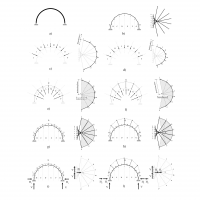 Design and exploration of externally post-tensioned structures using graphic staticsLeonardo Todisco, Corentin Fivet, Hugo Corres, and Caitlin Mueller, Proceedings of the International Association for Shell and Spatial Structures (IASS) Symposium 2015, 2015
Design and exploration of externally post-tensioned structures using graphic staticsLeonardo Todisco, Corentin Fivet, Hugo Corres, and Caitlin Mueller, Proceedings of the International Association for Shell and Spatial Structures (IASS) Symposium 2015, 2015Funicular structures, which follow the shapes of hanging chains, work in pure tension (cables) or pure compression (arches), and offer a materially efficient solution compared to structures that work through bending action. However, the set of geometries that are funicular under common loading conditions is limited. Non-structural design criteria, such as function, program, and aesthetics, often prohibit the selection of purely funicular shapes, resulting in large bending moments and excess material usage. In response to this issue, this paper explores the use of a new design approach that converts non-funicular planar curves into funicular shapes without changing the geometry; instead, funicularity is achieved through the introduction of new loads using external post-tensioning. The methodology is based on graphic statics, and is generalized for any two-dimensional shape. The problem is indeterminate, meaning that a large range of allowable solutions is possible for one initial geometry. Each solution within this range results in different internal force distributions and horizontal reactions. The method has been implemented in an interactive parametric design environment, empowering fast exploration of diverse axial-only solutions. In addition to presenting the approach and tool, this paper provides a series of case studies and numerical comparisons between new post-tensioned structures and classical bending solutions, demonstrating that significant material can be saved without compromising on geometrical requirements.
-
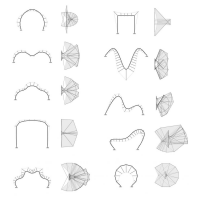 Design and exploration of externally post-tensioned structures using graphic staticsLeonardo Todisco, Corentin Fivet, Hugo Corres, and Caitlin Mueller, Journal of the IASS, 2015
Design and exploration of externally post-tensioned structures using graphic staticsLeonardo Todisco, Corentin Fivet, Hugo Corres, and Caitlin Mueller, Journal of the IASS, 2015Funicular structures, which follow the shapes of hanging chains, work in pure tension (cables) or pure compression (arches), and offer a materially efficient solution compared to structures that work through bending action. However, the set of geometries that are funicular under common loading conditions is limited. Non-structural design criteria, such as function, program, and aesthetics, often prohibit the selection of purely funicular shapes, resulting in large bending moments and excess material usage. In response to this issue, this paper explores the use of a new design approach that converts non-funicular planar curves into funicular shapes without changing the geometry; instead, funicularity is achieved through the introduction of new loads using external post-tensioning. The methodology is based on graphic statics, and is generalized for any two-dimensional shape. The problem is indeterminate, meaning that a large range of allowable solutions is possible for one initial geometry. Each solution within this range results in different internal force distributions and horizontal reactions. The method has been implemented in an interactive parametric design environment, empowering fast exploration of diverse axial-only solutions. In addition to presenting the approach and tool, this paper provides a series of case studies and numerical comparisons between new post-tensioned structures and classical bending solutions, demonstrating that significant material can be saved without compromising on geometrical requirements.
-
 Funicularity through external post-tensioning: design philosophy and computational toolLeonardo Todisco, Hugo Corres, and Caitlin Mueller, Journal of Structural Engineering (ASCE), 2015
Funicularity through external post-tensioning: design philosophy and computational toolLeonardo Todisco, Hugo Corres, and Caitlin Mueller, Journal of Structural Engineering (ASCE), 2015Funicular geometries, which follow the idealized shapes of hanging chains under a given loading, are recognized as materially efficient structural solutions because they exhibit no bending under design loading, usually self-weight. However, there are circumstances in which non-structural conditions make a funicular geometry difficult or impossible. This paper presents a new design philosophy, based on graphic statics, that shows how bending moments in a non-funicular two-dimensional curved geometry can be eliminated by adding forces through an external post-tensioning system. An interactive parametric tool is introduced for finding the layout of a post-tensioning tendon for any structural geometry. The effectiveness of this approach is shown with several new design proposals.
-
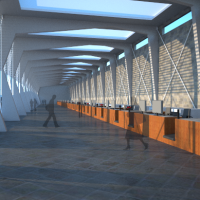 Combining structural performance and designer preferences in evolutionary design space explorationCaitlin Mueller and John Ochsendorf, Automation in Construction, 2015
Combining structural performance and designer preferences in evolutionary design space explorationCaitlin Mueller and John Ochsendorf, Automation in Construction, 2015This paper addresses the need to consider both quantitative performance goals and qualitative requirements in conceptual design. A new computational approach for design space exploration is proposed that extends existing interactive evolutionary algorithms for increased inclusion of designer preferences, overcoming the weaknesses of traditional optimization that have limited its use in practice. This approach allows designers to set the evolutionary parameters of mutation rate and generation size, in addition to parent selection, in order to steer design space exploration. This paper demonstrates the potential of this approach through a numerical parametric study, a software implementation, and series of case studies.


